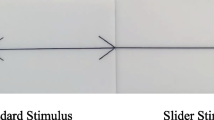Abstract
Recent studies have suggested important similarities between the visual control of upper and lower limb actions despite the different effectors, time scales, and regions of space associated with the two types of actions. Drawing on previous findings from upper limb studies, we show here that the effect of a Muller-Lyer illusion on stepping amplitude is greatly increased when the target display is occluded as compared to when it is visible during the reaction time period (i.e., brief delay and 3-s delay conditions versus full vision and open-loop conditions). The present results suggest that the control of stepping is mediated by different systems when the target is visible as compared to when it is occluded immediately before movement initiation; when target vision is not available during the reaction time period, the control of stepping is more highly dependent upon a non-veridical, perceptual representation of the target environment. These findings are consistent with the idea that, much like grasping, vision during the reaction time period is critical for the optimal control of stepping; that is, the visual control of stepping operates in real time.


Similar content being viewed by others
References
Carey DP (2001) Do action systems resist visual illusions? Trends Cogn Sci 5:109–113
Creem SH, Proffitt DR (1998) Two memories for geographical slant: separation and interdependence of action and awareness. Psych Bull Rev 5:22–36
Franz VH (2001) Action does not resist visual illusions. Trends Cogn Sci 5:457–459
Glover S, Dixon P (2004) A step and a hop on the Muller-Lyer: illusion effects on lower-limb movement. Exp Brain Res 154:504–512
Goodale MA, Westwood DA (2004) An evolving view of duplex vision: separate but interacting pathways for perception and action. Curr Opin Neurobiol 14:203–211
Goodale MA, Milner AD, Jakobson LS, Carey DP (1991) A neurological dissociation between perceiving objects and grasping them. Nature 349:154–156
Goodale MA, Meenan JP, Bulthoff HH, Nicolle DA, Murphy KJ, Racicot CI (1994) Separate neural pathways for the visual analysis of object shape in perception and prehension. Curr Biol 4:604–610
Goodale MA, Westwood DA, Milner AD (2004) Two distinct modes of control for object-directed action. Prog Brain Res 144:131–144
James TW, Culham J, Humphrey GK, Milner AD, Goodale MA (2003) Ventral occipital lesions impair object recognition but not object-directed grasping: an fMRI study. Brain 126:2463–2475
Jeannerod M (1986) The formation of finger grip during prehension. A cortically mediated visuomotor pattern. Behav Brain Res 19:99–116
Milgram P (1987) A spectacle-mounted liquid-crystal tachistoscope. Behav Res Meth :Instr Comp 19:449–456
Milner AD, Dyde R (2003) Why do some perceptual illusions affect visually guided action, when others don’t? Trends Cogn Sci 7:10–11
Palmer SE (1999) Vision science: photons to phenomenology. MIT, Cambridge
Patla AE, Goodale MA (1996) Obstacle avoidance during locomotion is unaffected in a patient with visual form agnosia. Neuroreport 8:165–168
Rossignol S (1996) Visuomotor regulation of locomotion. Can J Physiol Pharm 74:418–425
Westwood DA, Goodale MA (2003) Perceptual illusion and the real-time control of action. Spat Vis 16:243–254
Wraga M, Creem SH, Proffitt DR (2000) Perception-action dissociation of a walkable Muller-Lyer configuration. Psych Sci 11:239–243
Acknowledgments
This project was funded by an NSERC Discovery grant to D. A. Westwood. The authors thank Chris Thomas and Bud Eisener for technical support.
Author information
Authors and Affiliations
Corresponding author
Rights and permissions
About this article
Cite this article
McCarville, E.M., Westwood, D.A. The visual control of stepping operates in real time: evidence from a pictorial illusion. Exp Brain Res 171, 405–410 (2006). https://doi.org/10.1007/s00221-005-0284-7
Received:
Accepted:
Published:
Issue Date:
DOI: https://doi.org/10.1007/s00221-005-0284-7




